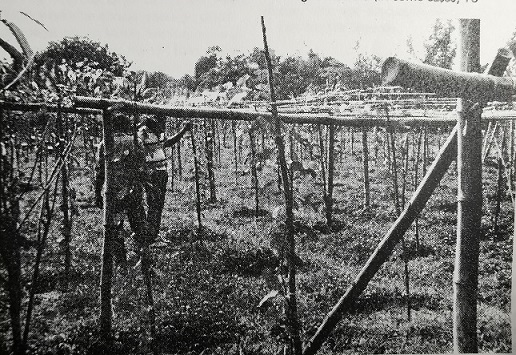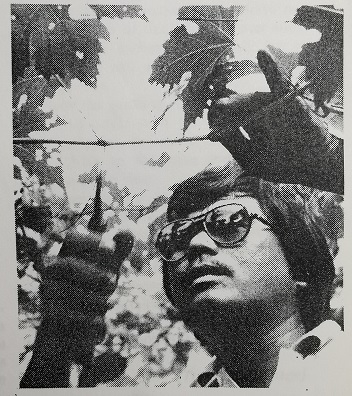Consider
a one-hectare farm. How can one get the most profit from it?
Most experts will probably recommend an integrated
farming system where a portion of the l and is cultivated to
various crops while the remaining area will be allocated to
animal raising or other projects. True enough, numerous
reports reveal how this and that farmer earned handsomely
from his integrated farm. and is cultivated to
various crops while the remaining area will be allocated to
animal raising or other projects. True enough, numerous
reports reveal how this and that farmer earned handsomely
from his integrated farm.
On the other hand, very few, if any, will recommend a
one-cropping system or a system where there is one major
crop plus one or two alternate crops. Indeed, there is
hardly any single crop system which can outearn an
integrated farm on a per hectare basis.
But look again - there is one crop which promises to
generate incomes ranging in the hundreds of thousands of
pesos. That crop is GRAPE. hundreds of thousands of
pesos. That crop is GRAPE.
Bernardo O. Dizon, viticulturist and father of the
variety known as "Miracle grape," provides the following
figures.
Planting at a distance of two meters between plants and
two-and-a-half meters between rows, one hectare can
accommodate 2,000 vines. The initial investment is estimated
at P80,000, which covers just about every expense, including
the cost of planting materials, labor chemical inputs and
miscellaneous expenses.
With proper care and maintenance, each vine can be made
to produce from three to five kilos of berries in the first
year. This means a total harvest of six to 10 tons.
The current price of grapes at whole-sale level is
about P35. Assuming that there will be a glut in the market
and that the price will sink down to only P20 per kilo, this
will still mean a gross income of P120,000 to P200,000,
leaving a net profit of P40,000 to P80,000.
In the second year, the vines will become more
productive and will produce more berries. According to
Dizon, production increases each year until the vines attain
an average of 20 to 25 kilos a year.
At 20 kilos per vine, the total production from one
hectare will be 40,000 kilos. Assuming that the price will
go down further to P10 per kilo, total gross income will
come to around P400,000.
This is a conservative estimate, considering that some
vines yield as much as 30 kilos in one year.
Meanwhile, the cost of production will go down starting
in the second year. This is because the farmer will no
longer have to buy planting materials.
 The above computation is merely hypothetical, but it is
not impossible to attain, said Dizon, who is becoming
increasingly famous for his development of the so-called
"Miracle grape." The above computation is merely hypothetical, but it is
not impossible to attain, said Dizon, who is becoming
increasingly famous for his development of the so-called
"Miracle grape."
The "Miracle grape," according to Dizon, can be induced
to bear, fruit within eight months (in some cases, 16 weeks)
from planting while other varieties will take more than one
year before they begin to bear fruit. Actually, the miracle
variety can be scheduled to fruit so that harvesting will
coincide with a special occasion, say a birthday party or
the Christmas celebration.
Dizon's
miracle grape is a cross between the White Malaga and the
Brazillian hybrid. The berries are colored green and turn
yellowish when ripe. The taste is very sweet.
In the
United States and other traditional grape producing
countries, the green variety is the table grape, not the red
or black variety as Filipinos have been made to believe,
explained Dizon. The red and black varieties are normally
made into wine but we have been made to believe otherwise so
that the excess production in these countries could be
dumped in the Philippines, he said.
But
this may not be for long. With the development of the
miracle variety. Dizon foresees the day when grapes will be
produced in large quantities locally and sold to Filipinos
consumers at affordable prices.
To
hasten the development of the local grape industry, Dizon
conducts a weekly series of seminars to encourage
prospective growers and teach them the basics of grape
growing. Once of those he has convinced is Cornelio de
Guzman, community editor of Bulletin Today.
De
Guzman started last year with 500 vines covering one-fourth
hectare. Then he expanded his vineyard to one-half hectare
planted with 1,000 vines. While it is still too early to
count the eggs, all indications point to a successful
operation for De Guzman.
As for
himself, Dizon has a two-hectare farm in his native Bongabon,
Nueva Ecija where he concentrates on plant propagation. In
Metro Manila, he runs a small garden near the UP Bliss site
in Diliman, Quezon City. Aside from grapes, the garden
produces various other planting materials like giant
calamansi, seedless atis, apple mango, native dayap,
American lemon, ladu, zcinkum, Tahiti lime, atemoya, santol
Bangkok, Java guava and other uncommon species.
In
addition, Dizon acts as a consultant to a two-hectare
vineyard in Cavite. To emphasize the potentials of grapes,
Dizon revealed that a customer is buying the fruits of the
Cavite farm even before they are harvested.
The
current outlook of grapes is in sharp contrast with the
situation in the early days of grape culture in the
Philippines.
Actually, Dizon said, grape culture has been practiced in
the Philippines as early as the 1920s. During that time,
however, grapes were grown primarily for its novelty and
fascination of the farmer in being able to grow a foreign
plant. There was little regard for its economic value, he
observed.
Then
after the second world war, a breakthrough was achieved .
Cebu planters began to raise grapes in commercial scale, he
continued. Soon, thereafter, other planters in Zamboanga,
Batangas, Pampanga, Nueva Ecija and other provinces followed
suit.
In
1979, however, local dailies reported that the grape
industry in Cebu was dying. Erlinda Belen of the Philippine
Council for Agriculture and Resources Research reported that
only 65 hectares of the 350 hectares have remained attented
to. This was attributed to the lack of adequate technology
to solve the various problems which grape grower faced
during that time. For instance, the Cebu vines suffered
serious declines in productivity after three years. This was
compounded by the rising prices of fertilizers and
pesticides. In the first place, there were yet no grape
varieites which had sufficient resistance to pests and
disease, Dizon observed.
Dizon
has his own analysis of what happened in Cebu. He said the
main reasons for the downfall of the grape industry in Cebu
lie in their pruning technique, the kind of planting
material and the variety that they used and cultural
practices such as cultivation, hilling-up.
PRUNING TECHNIQUE
The
ordinary pruning or spur pruning is good only during the
first two to three years. After three years, Cebu grape
growers cut back the vine to maintain the crown of one to
two meters. At this time, the fruiting vines have grown two
meters and sometimes as far as six meters. When the vines
are cut-back to one to two meters, no fruits come out.
PLANTING MATERIALS
Rooted
cutting is generally used as planting material. In temperate
countries they allow a rooted cutting to establish more
roots by keeping it far one year in a seedbed before it is
planted in the field. After that, it will take three to five
years before the vines are allowed to bear fruits.
In the
Philippines, (Cebu, in particular) rooted cuttings are
planted two to four months from date of cutting or pruning.
By that time, only a few roots (an average of 10) have
developed.
A
recent masteral Thesis about grape propagation showed that
marcotting has more advantages in terms of growth and
production. Marcotted vines or seedlings develop an average
of 100 strong roots. Since the root system is the foundation
of a plant, marcotted seedling thus outgrow rooted cutting
three to four times and have a longer life span.
VARIETY
Of the
thousand varieties grown abroad, very few survive and suit
local conditions. These are the Red Cardinal, Black Ribier,
Brazilian hybrid and recently the Miracle grapes. White
Malaga, which performed well in Thailand which has a similar
climate to the Philippines, failed in Cebu. Even in the
Philippines Red Cardinal is adapted only in places where
there is longer dry season and no distinct wet season.
CULTIVATION, HILLING-UP,
ETC.
It has
been the practice of Cebu growers to go into deep
cultivation around the base then hill-up prior to pruning.
This however, often results in damaged roots. Then when the
base of the trunk is hilled-up, fertilizer application and
water distribution becomes uneven. Furthermore, the hill
becomes a dwelling for soil insects (like ants grubs and
terminates) that destroy the roots.
Dizon,
himself, experienced many of these problems when he was
still with Roxas Y Cia Ltd. which operated a vineyard in
Nasugbu, Batangas from 1970-74. But he gained valuable
knowledge from that experience.
What
Dizon did was to reverse the grape culture of temperate
countries. The result was the miracle variety and a new
grape technology that proved superior over imported methods
on several counts.
Ulrich
Volkel, a German expert, wondered at how Dizon was able to
modify the conventional technique which has been practiced
for over a thousand years in Germany and other grape growing
countries.
Another German expert, Heinrich Bach, after tasting Dizon's
miracle grapes, said: "They are truly sweet and comparable
to imported ones." |

